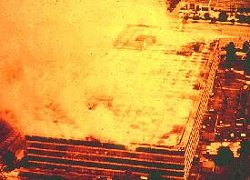National Personnel Records Center fire facts for kids

Fire underway, 1973, Aerial View of MILPERCEN, National Archives.
|
|
| Date | July 12-16, 1973 |
|---|---|
| Venue | National Personnel Records Center |
| Location | Overland, Missouri, United States |
| Type | Fire |
| Cause | Unknown |
The National Personnel Records Center fire of 1973 was a huge fire. It happened at a building in Overland, Missouri, near St. Louis. The fire lasted for several days, from July 12 to July 16, 1973.
This fire destroyed millions of important military records. These records belonged to people who had served in the U.S. military. The building, called the National Personnel Records Center (NPRC), stores these official documents. It is part of the National Archives and Records Administration, which keeps many historical records for the U.S. government.
Contents
What is the National Personnel Records Center?
The NPRC was created in 1956. It brought together different offices that kept records for military and government workers. Its job was to store the service records of people who worked for the federal government or served in the American military.
In the early 1950s, architects designed a new building for these records. They looked at other records centers to learn how to build it. They also thought about how to prevent fires. Some experts believed that sprinkler systems could cause more water damage than fire. Others thought sprinklers were very important for safety.
The building was finished in 1956. It had six floors, each very large. These floors were mostly open spaces for storing records. There were no special walls inside to stop a fire from spreading. Also, the building did not have smoke detectors or a sprinkler system. When it opened, it held about 38 million military records. By 1973, this number had grown to over 52 million.
How the Fire Started and Spread
The fire began just after midnight on July 12, 1973. A security guard and a passing motorcyclist reported seeing the fire. Fire trucks arrived quickly, within minutes. Many fire departments, 42 in total, came to help.
The heat and smoke inside the building became too much. Firefighters had to leave the building after a few hours. They then fought the fire from the outside. There wasn't enough water pressure, which made it harder to put out the flames. One of their main water pumps also broke down.
The fire burned out of control for 22 hours. Firefighters were able to go back inside on July 14. The fire continued to smolder for two more days. It was finally declared out on the morning of July 16. However, crews kept spraying water to stop it from restarting until the end of the month.
What Caused the Fire?
The exact reason for the fire was never fully known. An investigation in 1975 suggested that cigarette embers in trash cans might have caused it. Some people even thought an employee started it by smoking. However, investigators quickly said it was not arson (a fire started on purpose).
In 1974, investigators thought an electrical short circuit was the most likely cause. But because the sixth floor was almost completely destroyed, they couldn't fully check the electrical systems.
What Records Were Lost?
The fire destroyed a huge number of military records. Here are some of the losses:
- About 80% of U.S. Army records for people discharged between 1912 and 1960 were lost.
- About 75% of U.S. Air Force records for people discharged between 1947 and 1964 were lost. This mainly affected names starting with "Hubbard, James E." and later in the alphabet.
- Some U.S. Army Reserve records were also destroyed.
None of these destroyed records had backup copies. They also had not been copied onto microfilm (tiny pictures of documents). There was no list of these records before the fire. Millions of records were also being used by the Veterans Administration at the time. This made it very hard to know exactly which records were gone forever.
A small number of U.S. Navy and Marine Corps records were also lost. These records were on the sixth floor, where the fire caused the most damage. They were being used by employees at the time.
The exact number of these records is not known. They were not normally stored in that part of the building. It's thought that only a few dozen were affected. Some very important Navy and Marine Corps records were kept in a special security vault on the sixth floor. These included the Navy file of Andreas Papandreou, who later became the Prime Minister of Greece. The record of Adolf Hitler's nephew, William Patrick Hitler, was also destroyed.
Damage and Repairs
The fire completely destroyed the sixth floor of the building. The fifth floor also had a lot of water damage. Because of the severe damage, the entire sixth floor was removed. This means the building now has five floors instead of six.
During the repairs, many safety improvements were made. New firewalls were added to divide the large storage areas. Smoke detectors and sprinkler systems were also installed. These changes were made to help prevent another fire like the one in 1973. Even today, you can still see signs of the fire on the building.
After the fire, a big effort began in 1974 to try and rebuild the lost service records. For most records thought to be destroyed, the NPRC can still create basic information. This includes things like when someone joined the military, when they left, their rank, and how they served.

